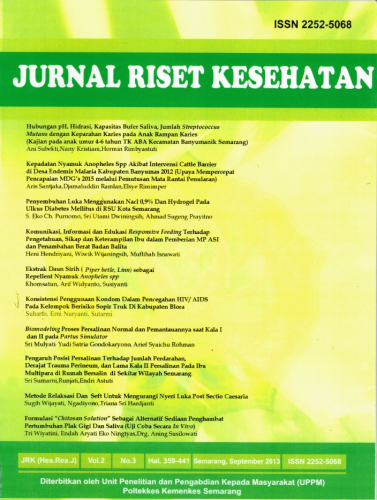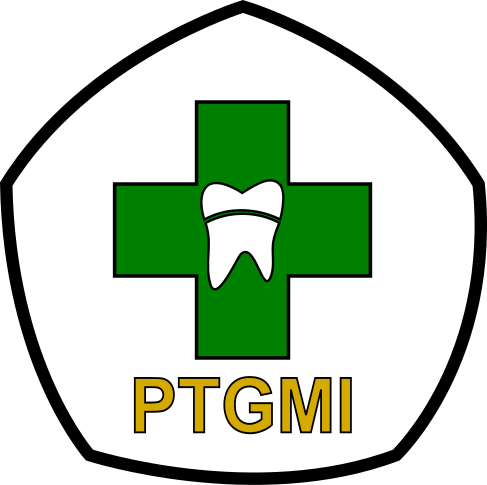POTENTIAL OF JAMBLANG (Syzygium cumini L.) LEAF EXTRACT ON BODY WEIGHT OF WISTAR RATS METABOLIC SYNDROME MODEL
Abstract
Jamblang (Syzygium cumini L.) leaves contain several phytochemical compounds. These phytochemicals are thought to have roles as antihyperglycemic, antihyperlipidemic, and antioxidant agents. This study aims to prove that there is an effect of giving ethanolic extract of jamblang leaves on body weight (BW) of metabolic syndrome (MS) Wistar rats induced by high-fat high-fructrose diet (HFFD) and injection of Streptozotocin (STZ)-Nicotinamide (Na), to determine different doses effect on the weight of Wistar rats. Laboratory experimental research with pre-post test control group. Samples were 8 weeks male Wistar (Rattus noverigicus) weighing 150-200 grams chosen by purposive random sampling method. Thirty rats were divided into 5 groups, each consisting of 6 rats. Normal group, metabolic syndrome group, 3 treatment groups MS were given jamblang leaf extract 100 mg/KgBW, 150mg/KgBW, 200mg/KgBW for 28 days. Data were analyzed by one way ANOVA test and repeated ANOVA test. The study showed an ethanolic extract of Jamblang leaves can reduce weight loss in Wistar rats with a metabolic syndrome model, and that the best dose used in this experiment is 150 mg/kgBW per day in Wistar rats with a metabolic syndrome model.
Keywords
Full Text:
PDFReferences
Atanasovska, E., Tasic, V., Slaninka-Miceska, M., Alabakovska, S., Zafirov, D., Kostova, E., & Labacevski, N. (2014). Six week follow-up of metabolic effects induced by a high-fat diet and streptozotocin in a rodent model of type 2 diabetes mellitus. Prilozi (Makedonska Akademija Na Naukite i Umetnostite. Oddelenie Za Medicinski Nauki), 35(1), 169–179.
Castro, A. V. B., Kolka, C. M., Kim, S. P., Bergman, R. N., Sinai, C., & Angeles, L. (2015). Obesity, Insulin Resistance and Comorbidities – Mechanisms of Association. Arquivos Brasileiros de Endocrinologia e Metabologia, 58(6), 600–609.
Chhikara, N., Kaur, R., Jaglan, S., Sharma, P., Gat, Y., & Panghal, A. (2018). Bioactive compounds and pharmacological and food applications of: Syzygium cumini-a review. Food and Function, 9(12), 6096–6115. https://doi.org/10.1039/c8fo00654g
Fan, J., Liu, Y., Yin, S., Chen, N., Bai, X., Ke, Q., & Xia, M. (2019). Small dense LDL cholesterol is associated with metabolic syndrome traits independently of obesity and inflammation. Nutrition and Metabolism, 16(1), 1–9. https://doi.org/10.1186/s12986-019-0334-y
Fernández-Sánchez, A., Madrigal-Santillán, E., Bautista, M., Esquivel-Soto, J., Morales-González, Á., Esquivel-Chirino, C., & Morales-González, J. A. (2011). Inflammation, oxidative stress, and obesity. International Journal of Molecular Sciences, 12(5), 3117–3132. https://doi.org/10.3390/ijms12053117
Gancheva, S., Zhelyazkova-Savova, M., Galunska, B., & Chervenkov, T. (2015). Experimental models of metabolic syndrome in rats. Scripta Scientifica Medica, 47(2), 14. https://doi.org/10.14748/ssm.v47i2.1145
Giacco, F., & Brownlee, M. (2010). Oxidative Stress and Diabetic Complications. Circulation Research, 107(9), 1058–1070. https://doi.org/10.1161/CIRCRESAHA.110.223545.Oxidative
Herningtyas, E. H., & Tian Sheng Ng. (2019). Prevalence and Distribution of Metabolic Syndrome and Its Components Among Provinces and Ethnic Groups in Indonesia. BMC Public Health, 19(377), 1–12.
Hidayati, L., Dwi, A., Widodo, W., Hidayat, B., Program, I. S., Java, E., & Airlangga, U. (2020). Animal Models with Metabolic Syndrome Markers Induced by High Fat Diet and Fructose. Medical Laboratory Technology Journal, 6(1), 13–20. https://doi.org/10.31964/mltj.v1i1.266
Hsieh, S., Chung, T., Li, Y., Lo, Y., Lin, N., Kuo, P., & Tzen, J. T. C. (2016). Ginkgoghrelins , unique acylated fl avonoid diglycosides in Folium Ginkgo , stimulate growth hormone secretion via activation of the ghrelin receptor. Journal of Ethnopharmacology, 193, 237–247. https://doi.org/10.1016/j.jep.2016.08.015
Husna, F., Suyatna, F. D., Arozal, W., & Purwaningsih, E. H. (2019). Model Hewan Coba pada Penelitian Diabetes. Pharmaceutical Sciences and Research, 6(3), 131–141. https://doi.org/10.7454/psr.v6i3.4531
Ihedioha, J. I., Noel-Uneke, O. A., & Ihedioha, T. E. (2013). Reference values for the serum lipid profile of albino rats (Rattus norvegicus) of varied ages and sexes. Comparative Clinical Pathology, 22(1), 93–99. https://doi.org/10.1007/s00580-011-1372-7
Joshi, M., Paudel, M., & Upreti, S. (2019). Therapeutic influence of Jamun ( Syzygium cumini ): A review. Journal of Pharmacognosy and Phytochemistry, 8(3), 1056–1059.
Marianti, A., Utami, N. R., & Christijanti, W. (2013). Aktivitas Antioksidan Madu Floral terhadap Profil Lipid Darah Tikus Putih Hiperlipidemik. Jurnal Sains Dan Teknologi, 11(1), 1–8.
Marliani, L., Kusriani, H., & Sari, I. (2014). Aktivitas Antioksidan Daun dan Buah Jamblang (Syzigium Cumini L.) Skeel. Sains, Teknologi Dan Kesehatan, 4(1), 201–206.
Ningrum, L. P., Salim, N., & Balqis, U. (2017). Pengaruh Ekstrak Daun Jamblang (Syzygium cumini L) Terhadap Histopatologi Hepar Tikus Putih (rattus norvegicus) Diabetes Melitus. Jurnal Ilmiah Mahasiswa Veteriner, 1(4), 695–701.
Osei-yeboah, J., Owiredu, W. K. B. A., Norgbe, G. K., Lokpo, S. Y., Gyamfi, J., Allotey, E. A., & Attah, F. A. (2017). The Prevalence of Metabolic Syndrome and Its Components among People with Type 2 Diabetes in the Ho Municipality , Ghana : A Cross-Sectional Study. International Journal of Chronic Diseases, 2017, 1–8.
Rahman, F., Oktomalioputri, B., & Irramah, M. (2020). Pengaruh Pemberian Ekstrak Daun Duwet ( Syzigium cumini ) Terhadap Gambaran Histologi Ginjal Tikus ( Rattus novergicus ) yang Diintoksikasi dengan Timbal Asetat. Jurnal Kesehatan Andalas, 9(1), 171–177.
Ramic, E., Prasko, S., Mujanovic, O. B., & Gavran, L. (2016). Metabolic Syndrome-Theory and Practice. Mater Sociomed, 28(1), 71–73. https://doi.org/10.5455/msm.2016.28.71-73
Rohman, M. S., Lukitasari, M., Nugroho, D. A., & Widodo, N. (2017). Development of an Experimental Model of Metabolic Syndrome in Sprague Dawley Rat. Research Journal Of Life Science, 04(01), 76–86.
Sari, A. N. (2017). Potensi Antioksidan Alami Pada Ekstrak Daun Jamblang (Syzigium cumini (L.) Skeels). Eksakta, 18(2), 107–112.
Shattat, G. F. (2014). A Review Article on Hyperlipidemia : Types , Treatments and New Drug Targets. Biomedical & Pharmacology Journal, 7(2), 399–409.
Singh, S., Singh, L., Sagar, B. P. ., & Das, M. (2018). Evaluation of Antihyperlipidemic Activity of Ethanolic Extract of Syzygium cumini in Triton X-100 Induced Hyperlipidemic Rats. International Journal of Pharmacy & Pharmaceutical Research, 12(3), 40–54.
Stevani, H. (2016). Modul Bahan Ajar Cetak Farmasi-Praktikum Farmakologi (1st ed.). Jakarta: Pusat Pendidikan Sumber Daya Manusia Kesehatan.
Suhaema, & Masthalina, H. (2015). Pola Konsumsi Dengan Terjadinya Sindrom Metabolik di Indonesia. Jurnal Kesehatan Masyarakat Nasional, 9(4), 340–347.
Suman, R. K., Mohanty, I. R., Borde, M. K., Maheshwari, U., & Deshmukh, Y. A. (2016). Development of an Experimental Model of Diabetes Co-Existing with Metabolic Syndrome in Rats. Advances in Pharmacological Science, 1–11. https://doi.org/10.1155/2016/9463476
Syafitri, V., Arnelis, A., & Efrida, E. (2015). Gambaran Profil Lipid Pasien Perlemakan Hati Non-Alkoholik. Jurnal Kesehatan Andalas, 4(1), 274–278. https://doi.org/10.25077/jka.v4i1.234
Wong, S. K., Chin, K. Y., Suhaimi, F. H., Fairus, A., & Ima-Nirwana, S. (2016). Animal models of metabolic syndrome: a review. Nutrition and Metabolism, 13(1), 1–12. https://doi.org/10.1186/s12986-016-0123-9
Wulansari, D. D., & Wulandari, D. D. (2018). Pengembangan Model Hewan Coba Tikus Diabetes Mellitus Tipe 2 dengan Induksi Diet Tinggi Fruktosa Intragastrik. Media Pharmaceutica Indonesiana, 2(1), 41–47.
Xiao, C., Dash, S., Morgantini, C., Hegele, R. A., & Lewis, G. F. (2016). Pharmacological targeting of the atherogenic dyslipidemia complex: The next frontier in CVD prevention beyond lowering LDL cholesterol. Diabetes, 65(7), 1767–1778. https://doi.org/10.2337/db16-0046
DOI: https://doi.org/10.31983/jrk.v10i2.7703
Article Metrics
Refbacks
- There are currently no refbacks.
Copyright (c) 2021 Jurnal Riset Kesehatan




















































